Pressure Performance of Highly Deviated Well in Low Permeability Carbonate Gas Reservoir Using a Composite Model
Abstract
1. Introduction
2. Physical Model
- (1)
- The reservoir is divided into two concentric radial composite regions. The physical properties of inner region are better than that of outer region.
- (2)
- Boundaries at top and bottom are closed both for inner and outer region. There is no closed outer boundary in the radial direction for outer region.
- (3)
- Both inner and outer region are treated as dual-porosity systems, consisting of matrix pores and natural fractures. Transfer between matrix and fractures is pseudo-steady flow.
- (4)
- Stress sensitivity effect and threshold pressure gradient are taken into account both in inner and outer region.
- (5)
- Permeabilities in both two regions are anisotropic in horizontal and vertical directions.
- (6)
- The effects of capillary force and gravity are neglected.
3. Mathematical Model
3.1. Basic Continuous Point Source Solution
3.2. Establishment of Mathematical Model
3.3. Solution of Mathematical Model
4. Results and Discussion
4.1. Validation
4.2. Pressure Transient Characteristics and Flow Regimes
- (1)
- Wellbore storage period. The pseudo-pressure and pseudo-pressure derivative are straight lines with 45°.
- (2)
- Transient flow under skin effect. The pseudo pressure derivative curve rises to a high point to form a “Hump” and then drops immediately.
- (3)
- Inclination angle dominated flow. The pseudo pressure derivative curve is mainly affected by the inclination angle of highly deviated well.
- (4)
- Interporosity flow between matrix and fractures in inner region. There is a “dip” on derivative curve which reflects the characteristics of dual medium.
- (5)
- Pseudo-radial flow in inner region. The pseudo-pressure derivative curve is an approximate horizontal line with value 0.5.
- (6)
- Transient flow between inner and outer region. The pseudo pressure derivative curve is an ascending line due to the poor physical properties of the outer region.
- (7)
- Interporosity flow between matrix and fractures in outer region. Similarly, “dip” appears.
- (8)
- Pseudo-radial flow of system. The pseudo pressure derivative curve is a rising line instead of horizontal line due to the non-Darcy effect.
4.3. Sensitivity Analysis of Pressure Responses
5. Conclusions
- (1)
- The validity of the proposed model was verified by matching it with another analytical model. It shows that the dual-porosity composite model can be used for well test interpretation of highly deviated well in carbonate gas reservoir.
- (2)
- The presence of non-Darcy flow effect can be diagnosed from the log-log curve. The pseudo-pressure derivative curve is a rising line instead of horizontal line due to the non-Darcy effect in pseudo-radial flow of system.
- (3)
- Permeability modulus and threshold pressure gradient will influence the characteristics of log-log curves from 4th flow stage on. The derivative curve will become upturned with the effects of them, and the greater the value, the higher curve rise.
- (4)
- The depth of dip in the measured curves can be used to identify storage capacity of matrix and fractures. The occurrence time of dip in measured curves can be used to identify the ability of inter-porosity flow.
- (5)
- In actual interpretation, the longer the pseudo-radial flow of inner region lasts, the larger the inner region. If the mobility ratio is less than 1, it could be inferred that the acidification effect is great.
- (6)
- Compared with other models, the model presented in this paper is more suitable for carbonate gas reservoir. With its high efficiency and simplicity, this proposed model will serve as a useful tool to evaluate the pressure performance for highly deviated well in carbonate gas reservoirs.
Author Contributions
Funding
Conflicts of Interest
Nomenclature
| CD | Dimensionless wellbore storage coefficient, dimensionless |
| S | Skin factor, dimensionless |
| s | Laplace transform parameter, dimensionless |
| Z | Real-gas compressibility factor, dimensionless |
| t | Time, s |
| qex | Matrix-to-fractures inter-porosity flow, m3/s |
| qsc | Production rate at surface conditions, m3/s |
| qscins | Production rate of continuous column source at surface conditions, m3/s |
| cft | Compressibility of gas and rock in fracture system, Pa−1 |
| cmt | Compressibility of gas and rock in matrix system, Pa−1 |
| r | Radial distance in natural fracture system, m |
| rw | Wellbore radius, m |
| pm | Pressure of matrix, Pa |
| pf | Pressure of natural fracture, Pa |
| pi | Initial reservoir pressure, Pa |
| mm | Pseudo-pressure of matrix system, Pa |
| mf | Pseudo-pressure of fracture system, Pa |
| M21 | Mobility ratio of outer region to inner region, fraction |
| μ | Gas viscosity, Pa·s |
| kfh | Horizontal permeability of natural fracture, m2 |
| kfv | Vertical permeability of natural fracture, m2 |
| km | Permeability of matrix, m2 |
| ρ | Gas density, kg/m3 |
| h | Reservoir thickness, m |
| Porosity of natural fracture, fraction | |
| Porosity of matrix, fraction | |
| L | Characteristic length, m |
| hw | Length of highly deviated well, m |
| θ | Deviation angle, ° |
| x | Pseudo pressure considering permeability modulus, Pa |
| ω | Storability ratio, dimensionless |
| γ | Permeability modulus, 1/Pa |
| λex | Inter-porosity flow coefficient, dimensionless |
| λm | Threshold pressure gradient, Pa/m |
| α | Shape factors, dimensionless |
| zw | Coordinates of source, m |
| z | z-coordinates of gas reservoir, m |
| Subscript | |
| i | Initial state |
| m | Matrix |
| f | Natural fracture |
| sc | Standard state |
| w | Wellbore/source |
| D | Dimensionless |
| 1 | Inner region |
| 2 | Outer region |
| Superscript | |
| ̅ | Laplace transform |
| ~ | Fourier transform |
Appendix A. Derivation of Continuous Point Source Equations
| Dimensionless Variables | Expression | Dimensionless Variables | Expression |
|---|---|---|---|
| Dimensionless wellbore radius | Dimensionless radius | ||
| Dimensionless distance of x coordinate | Dimensionless distance of y coordinate | ||
| Dimensionless vertical distance of mid-perforation | Dimensionless vertical distance | ||
| Dimensionless permeability modulus | Dimensionless pseudo threshold pressure gradient | ||
| Dimensionless deviation angle | Dimensionless time | ||
| Dimensionless pseudo-pressure of matrix system | Dimensionless length of highly deviated well | ||
| Dimensionless pseudo-pressure of fracture system | Dimensionless wellbore storage coefficient | ||
| Mobility ratio between outer and inner regions | Interporosity flow coefficient between fractures and matrix | ||
| Dimensionless pseudo-pressure | Storativity ratio of matrix system |
References
- Yue, P.; Xie, Z.; Huang, S.; Liu, H.; Liang, S.; Chen, X. The application of N2 huff and puff for IOR in fracture-vuggy carbonate reservoir. Fuel 2018, 234, 1507–1517. [Google Scholar] [CrossRef]
- Wang, L.; Yang, S.; Liu, Y.; Xu, W.; Deng, H.; Meng, Z.; Han, W.; Qian, K. Experiments on gas supply capability of commingled production in a fracture-cavity carbonate gas reservoir. Pet. Explor. Dev. 2017, 44, 824–833. [Google Scholar]
- Wei, G.; Yang, W.; Du, J.; Xu, C.; Zou, C.; Xie, W.; Wu, S.; Zeng, F. Tectonic features of Gaoshiti-Moxi paleo-uplift and its controls on the formation of a giant gas field, Sichuan Basin, SW China. Pet. Explor. Dev. 2015, 42, 283–292. [Google Scholar]
- Zhou, Z.; Wang, X.; Yin, G.; Yuan, S.; Zeng, S. Characteristics and genesis of the (Sinian) Dengying Formation reservoir in Central Sichuan, China. J. Nat. Gas Sci. Eng. 2016, 29, 311–321. [Google Scholar] [CrossRef]
- Zhao, L.; Chen, Y.; Ning, Z.; Fan, Z.; Wu, X.; Liu, L.; Chen, X. Stress sensitive experiments for abnormal overpressure carbonate reservoirs: A case from the Kenkiyak low-permeability fractured-porous oilfield in the littoral Caspian Basin. Pet. Explor. Dev. 2013, 40, 194–200. [Google Scholar]
- Warren, J.E.; Root, P.J. The behavior of naturally fractured reservoirs. Soc. Pet. Eng. J. 1963, 3, 245–255. [Google Scholar] [CrossRef]
- Abdassah, D.; Ershaghi, I. Triple-porosity systems for representing naturally fractured reservoirs. SPE Form. Eval. 1986, 1, 113–127. [Google Scholar] [CrossRef]
- Camacho-Velazquez, R.; Vasquez-Cruz, M.; Castrejon-Aivar, R.; Arana-Ortiz, V. Pressure transient and decline curve behaviors in naturally fractured vuggy carbonate reservoirs. In Proceedings of the SPE Annual Technical Conference and Exhibition, San Antonio, TX, USA, 29 September–2 October 2020. [Google Scholar]
- Al-Ghamdi, A.; Ershaghi, I. Pressure transient analysis of dually fractured reservoirs. SPE J. 1996, 1, 93–100. [Google Scholar] [CrossRef]
- Li, Z.; Duan, Y.; Wei, M.; Peng, Y.; Chen, Q. Pressure performance of interlaced fracture networks in shale gas reservoirs with consideration of induced fractures. J. Pet. Sci. Eng. 2019, 178, 294–310. [Google Scholar] [CrossRef]
- Chen, P.; Wang, X.; Liu, H.; Huang, Y.; Chen, S.; Zhang, H. A pressure-transient model for a fractured-vuggy carbonate reservoir with large-scale cave. Geosyst. Eng. 2016, 19, 69–76. [Google Scholar] [CrossRef]
- He, J.; Killough, J.E.; Fadlelmula, F.; Mohamed, M.; Fraim, M. A unified finite difference model for the simulation of transient flow in naturally fractured carbonate karst reservoirs. In Proceedings of the SPE Reservoir Simulation Symposium, Houston, TX, USA, 23–25 February 2015. [Google Scholar]
- Agada, S.; Chen, F.; Geiger, S.; Toigulova, G.; Agar, S.; Shekhar, R.; Benson, G.; Hehmeyer, O.; Amour, F.; Mutti, M. Numerical simulation of fluid-flow processes in a 3D high-resolution carbonate reservoir analogue. Pet. Geosci. 2014, 20, 125–142. [Google Scholar]
- Li, L.; Huang, J.; Luo, C.; Du, F.; Liu, Y. Study on Productivity Numerical Simulation of Highly Deviated and Fractured Wells in Deep Oil and Gas Reservoirs. In Proceedings of the MATEC Web of Conferences; EDP Sciences: Société Chimique de France, France, 2016; p. 07003. [Google Scholar]
- Medeiros, F.; Ozkan, E.; Kazemi, H. A semianalytical, pressure-transient model for horizontal and multilateral wells in composite, layered, and compartmentalized reservoirs. In Proceedings of the SPE Annual Technical Conference and Exhibition, San Antonio, TX, USA, 24–27 September 2006. [Google Scholar]
- Olarewaju, J.S.; Lee, W.J. An analytical model for composite reservoirs produced at either constant bottomhole pressure or constant rate. In Proceedings of the SPE Annual Technical Conference and Exhibition, Dallas, TX, USA, 27–30 September 1987. [Google Scholar]
- Olarewaju, J.S.; Lee, W.J. A comprehensive application of a composite reservoir model to pressure transient analysis. In Proceedings of the SPE California Regional Meeting, Ventura, CA, USA, 8–10 April 1987. [Google Scholar]
- Wei, M.; Duan, Y.; Dong, M.; Fang, Q. Blasingame decline type curves with material balance pseudo-time modified for multi-fractured horizontal wells in shale gas reservoirs. J. Nat. Gas Sci. Eng. 2016, 31, 340–350. [Google Scholar] [CrossRef]
- Zeng, H.; Fan, D.; Yao, J.; Sun, H. Pressure and rate transient analysis of composite shale gas reservoirs considering multiple mechanisms. J. Nat. Gas Sci. Eng. 2015, 27, 914–925. [Google Scholar] [CrossRef]
- Zhang, L.; Guo, J.; Liu, Q. A well test model for stress-sensitive and heterogeneous reservoirs with non-uniform thicknesses. Pet. Sci. 2010, 7, 524–529. [Google Scholar] [CrossRef][Green Version]
- Yang, Y.; Liu, Z.; Sun, Z.; An, S.; Zhang, W.; Liu, P.; Yao, J.; Ma, J. Research on stress sensitivity of fractured carbonate reservoirs based on CT technology. Energies 2017, 10, 1833. [Google Scholar] [CrossRef]
- Wu, H.; Li, F.; Liu, J.; Chen, J.; Lv, X.; Hu, W. An experimental study on low-velocity nonlinear flow in vuggy carbonate reservoirs. Geosyst. Eng. 2016, 19, 151–157. [Google Scholar] [CrossRef]
- Wang, K.; Wang, L.; Adenutsi, C.D.; Li, Z.; Yang, S.; Zhang, L.; Wang, L.; Wen, P.H. Analysis of Gas Flow Behavior for Highly Deviated Wells in Naturally Fractured-Vuggy Carbonate Gas Reservoirs. Math. Probl. Eng. 2019, 2019, 6919176. [Google Scholar] [CrossRef]
- Wang, Y.; Yi, X. Flow modeling of well test analysis for a multiple-fractured horizontal well in triple media carbonate reservoir. Int. J. Nonlinear Sci. Numer. Simul. 2018, 19, 439–457. [Google Scholar] [CrossRef]
- Wei, M.; Duan, Y.; Dong, M.; Fang, Q.; Dejam, M. Transient production decline behavior analysis for a multi-fractured horizontal well with discrete fracture networks in shale gas reservoirs. J. Porous Media 2019, 22, 343–361. [Google Scholar] [CrossRef]
- Meng, F.; Lei, Q.; He, D.; Yan, H.; Jia, A.; Deng, H.; Xu, W. Production performance analysis for deviated wells in composite carbonate gas reservoirs. J. Nat. Gas Sci. Eng. 2018, 56, 333–343. [Google Scholar] [CrossRef]
- Wang, H. Performance of multiple fractured horizontal wells in shale gas reservoirs with consideration of multiple mechanisms. J. Hydrol. 2014, 510, 299–312. [Google Scholar] [CrossRef]
- Cinco, H.; Miller, F.G.; Ramey, H.J., Jr. Unsteady-state pressure distribution created by a directionally drilled well. J. Pet. Technol. 1975, 27, 1392–1400. [Google Scholar] [CrossRef]
- Van Everdingen, A.F. The Skin Effect and Its Influence on the Productive Capacity of a Well. Trance AIME 1953, 198, 171–176. [Google Scholar] [CrossRef]
- Peng, Y.; Zhao, J.; Sepehrnoori, K.; Li, Y.; Yu, W.; Zeng, J. Study of the Heat Transfer in the Wellbore During Acid/Hydraulic Fracturing Using a Semianalytical Transient Model. SPE J. 2019, 24, 877–890. [Google Scholar] [CrossRef]
- Peng, Y.; Zhao, J.; Sepehrnoori, K.; Li, Z.; Xu, F. Study of delayed creep fracture initiation and propagation based on semi-analytical fractional model. Appl. Math. Model. 2019, 72, 700–715. [Google Scholar] [CrossRef]
- Peng, Y.; Zhao, J.; Sepehrnoori, K.; Li, Z. Fractional model for simulating the viscoelastic behavior of artificial fracture in shale gas. Eng. Fract. Mech. 2020, 228, 106892. [Google Scholar] [CrossRef]
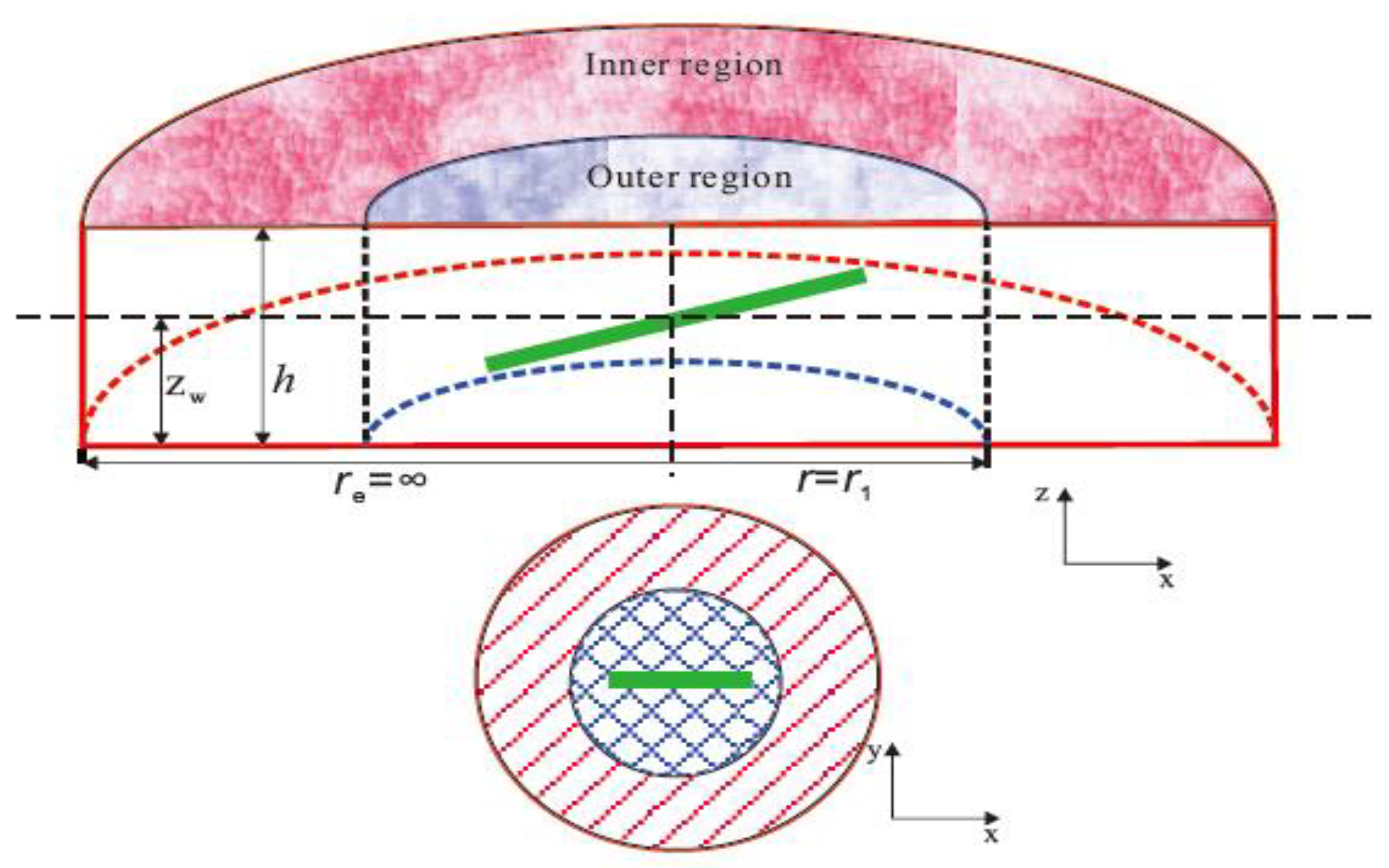
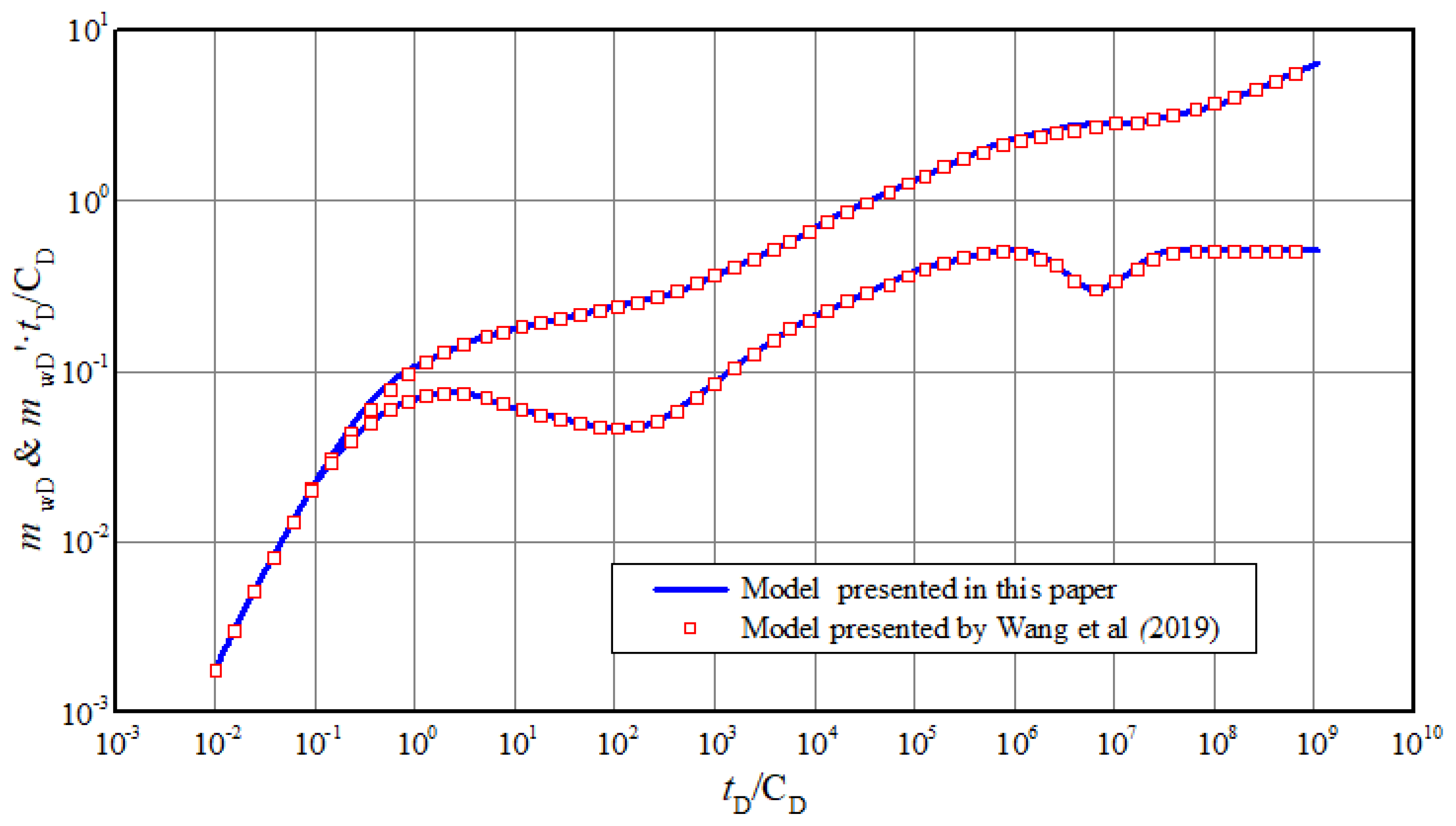
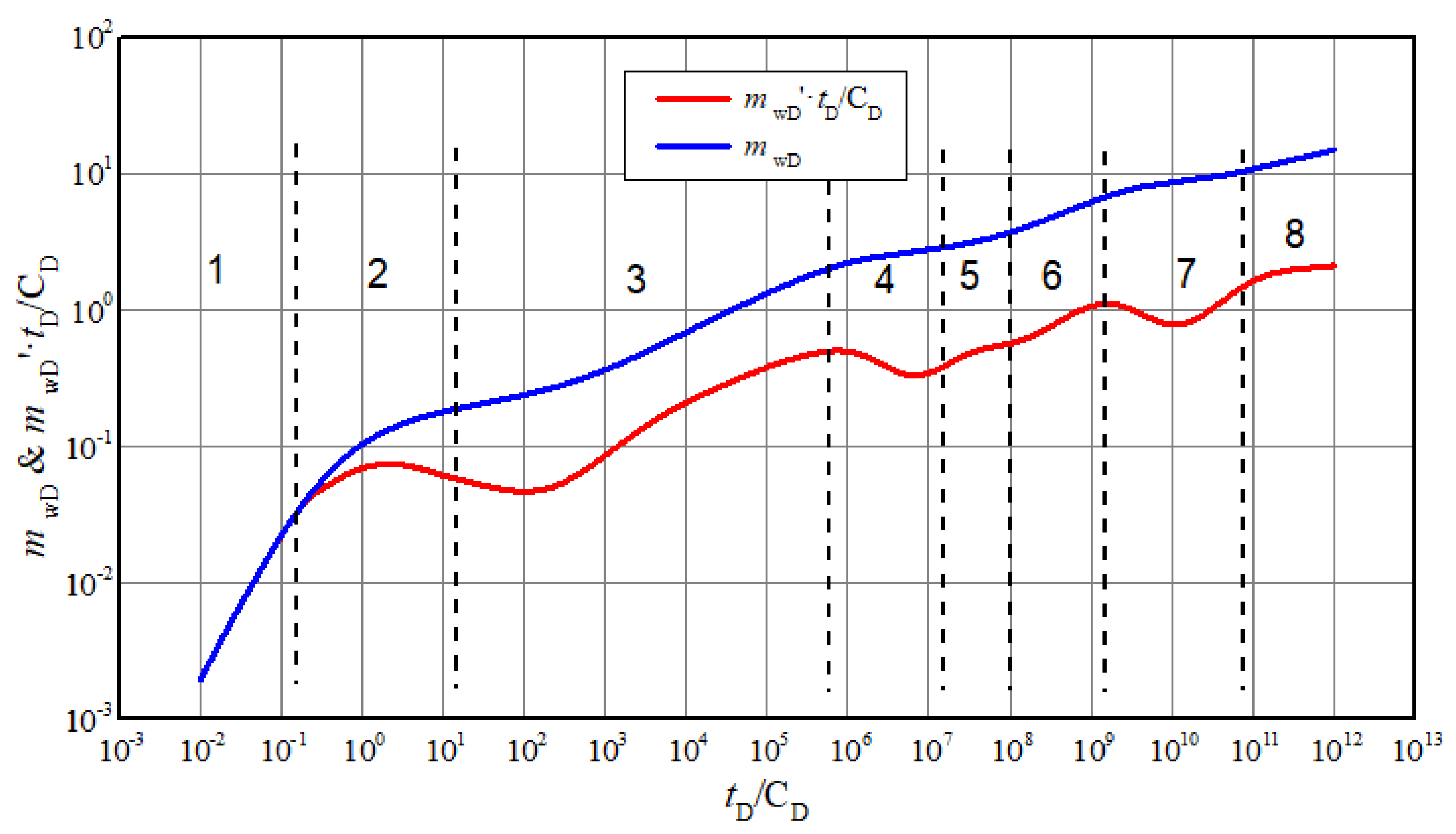
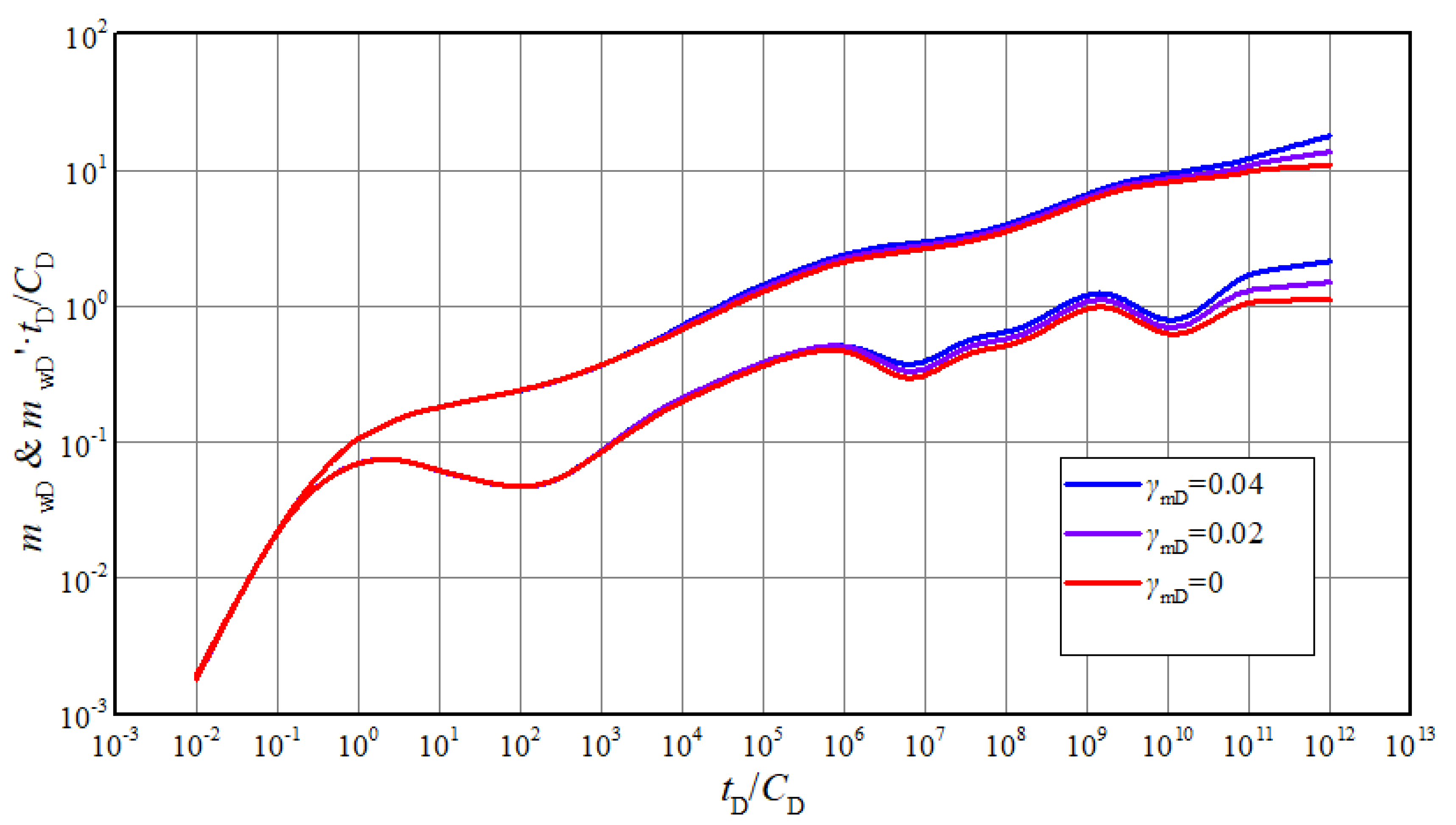
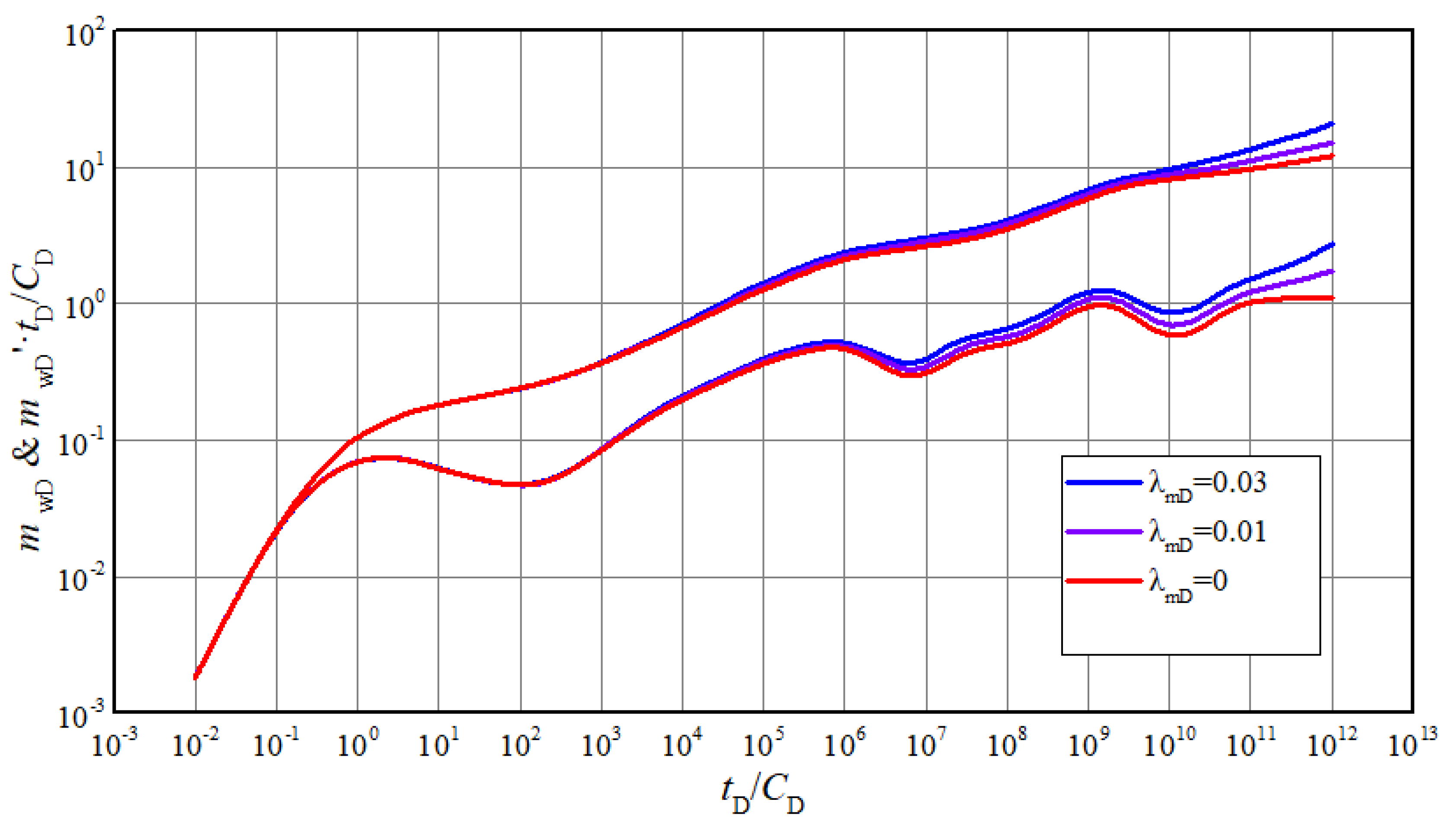
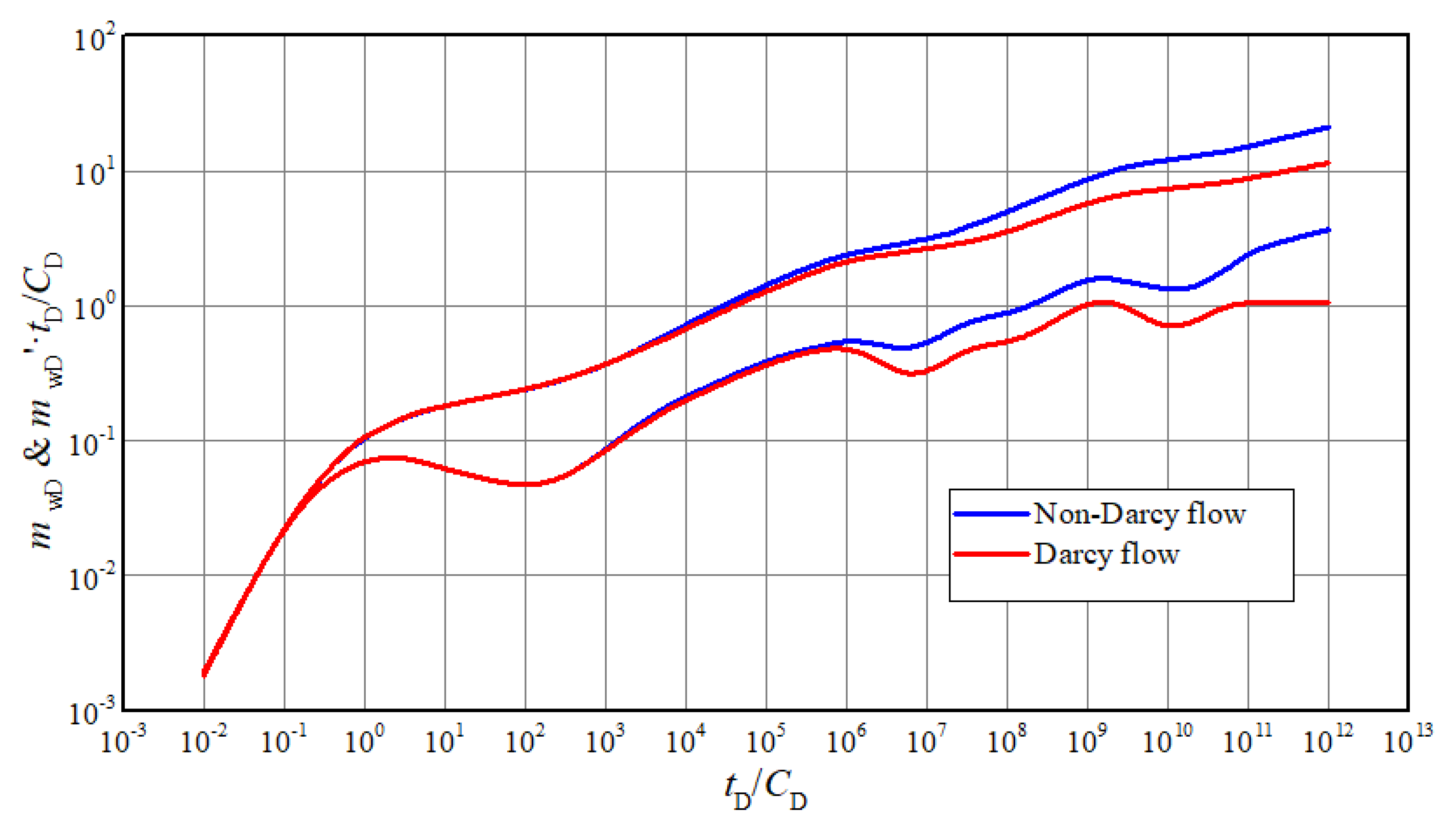

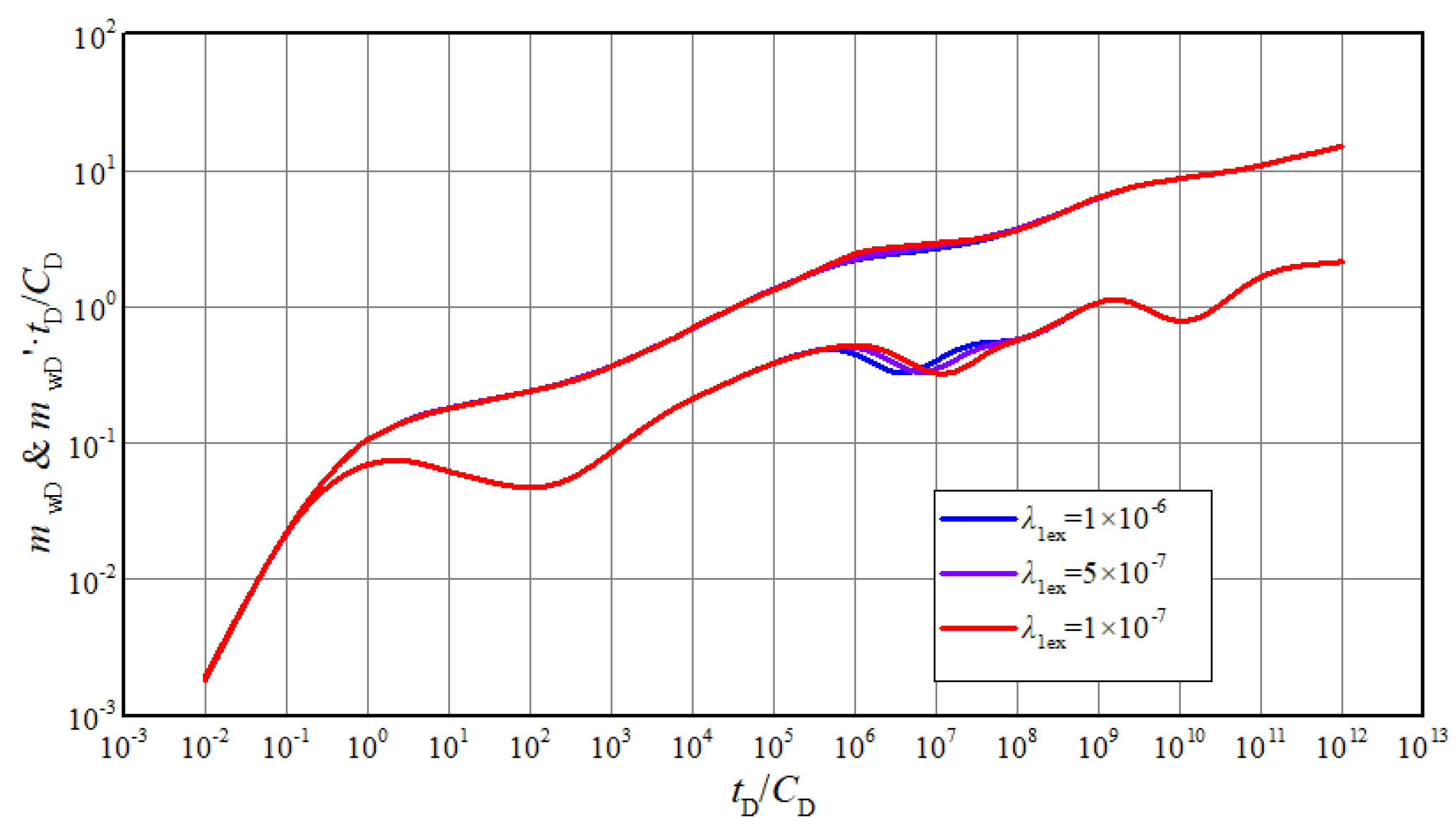
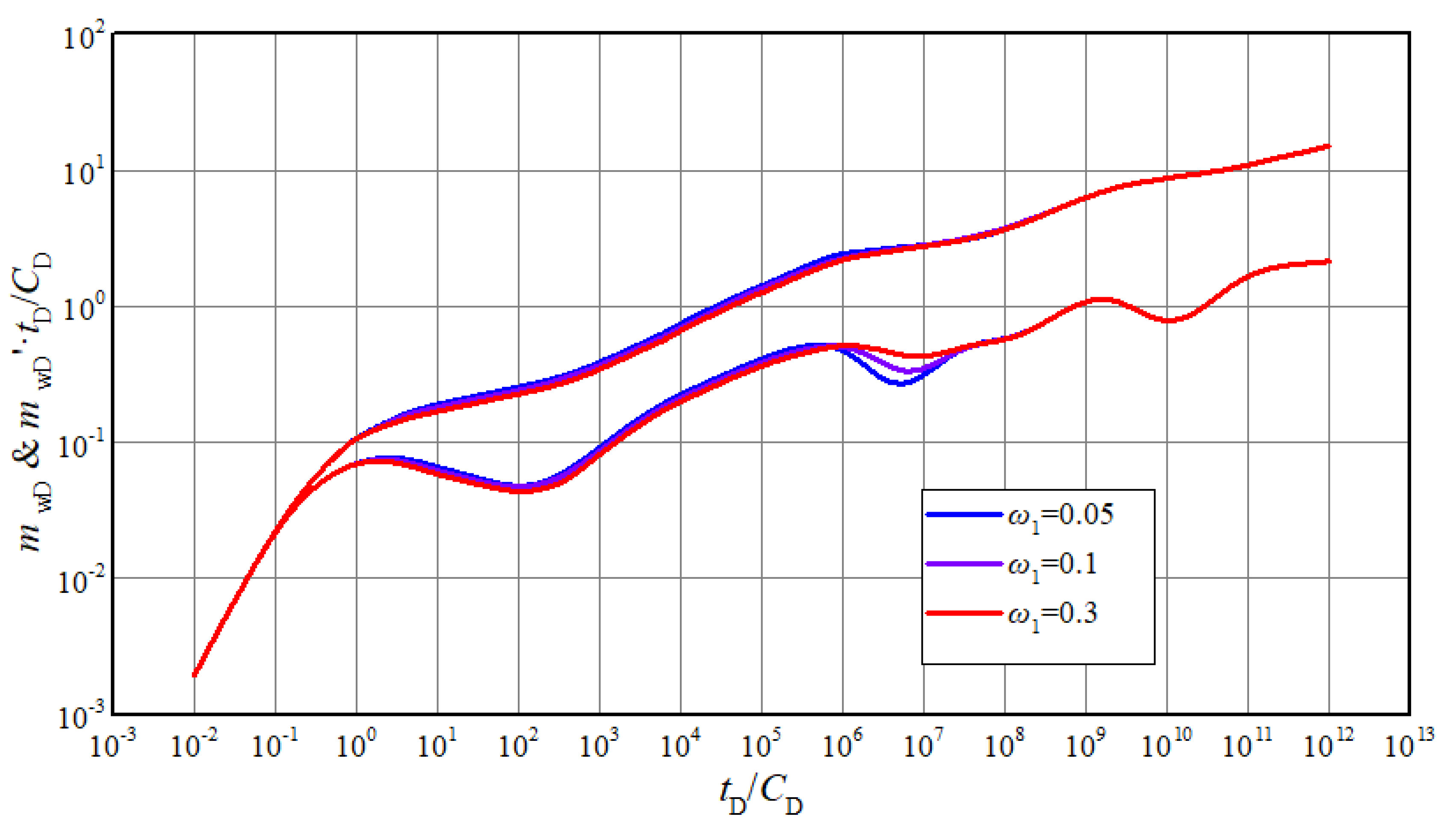
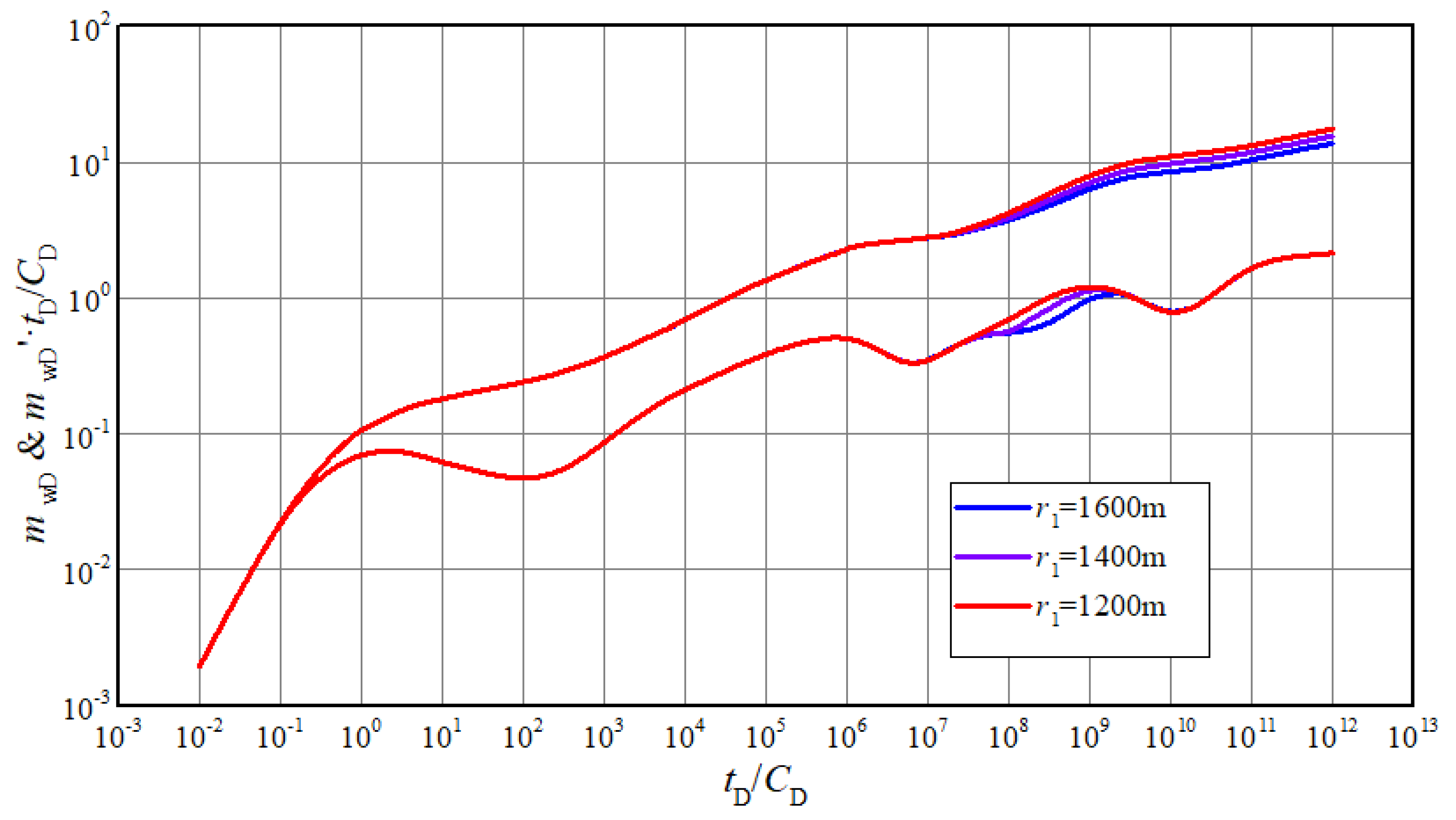
| Parameters | Value | Parameters | Value |
|---|---|---|---|
| Wellbore storage coefficient, CD | 10−6 | Skin factor, S | 0.1 |
| Deviation angle θ (°) | 75 | Wellbore radius, rw (m) | 0.1 |
| Length of the highly deviated well, hw (m) | 300 | Formation thickness, h (m) | 40 |
| Permeability ratio, kfv/kfh | 1 | Permeability modulus, γmD | 0 |
| Threshold pressure gradient, λmD | 0 | Mobility ratio, M21 | 1 |
| Inter-porosity flow coefficient, λex | 10−8 | Storability ratio, ω | 0.1 |
Publisher’s Note: MDPI stays neutral with regard to jurisdictional claims in published maps and institutional affiliations. |
© 2020 by the authors. Licensee MDPI, Basel, Switzerland. This article is an open access article distributed under the terms and conditions of the Creative Commons Attribution (CC BY) license (http://creativecommons.org/licenses/by/4.0/).
Share and Cite
Zhang, Q.; Zhang, L.; Liu, Q.; Jiang, Y. Pressure Performance of Highly Deviated Well in Low Permeability Carbonate Gas Reservoir Using a Composite Model. Energies 2020, 13, 5952. https://doi.org/10.3390/en13225952
Zhang Q, Zhang L, Liu Q, Jiang Y. Pressure Performance of Highly Deviated Well in Low Permeability Carbonate Gas Reservoir Using a Composite Model. Energies. 2020; 13(22):5952. https://doi.org/10.3390/en13225952
Chicago/Turabian StyleZhang, Qinwen, Liehui Zhang, Qiguo Liu, and Youshi Jiang. 2020. "Pressure Performance of Highly Deviated Well in Low Permeability Carbonate Gas Reservoir Using a Composite Model" Energies 13, no. 22: 5952. https://doi.org/10.3390/en13225952
APA StyleZhang, Q., Zhang, L., Liu, Q., & Jiang, Y. (2020). Pressure Performance of Highly Deviated Well in Low Permeability Carbonate Gas Reservoir Using a Composite Model. Energies, 13(22), 5952. https://doi.org/10.3390/en13225952




